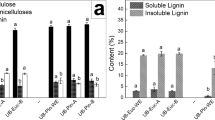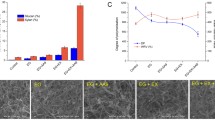Abstract
Nanofibrillated cellulose (NFC) extracted from biomass has potential applications in material science and biomedical engineering. In this study, NFC was obtained from bleached eucalyptus Kraft pulp (BEKP) using two commercial enzyme cocktails with cellulolytic and hemicellulolytic activities and non-catalytic protein (swollenin), followed by ultrasonication. This work represents an initial study of the implementation of non-catalytic proteins along with enzymes to extract NFC from biomass. Enzymatic pretreatment was performed to partially remove hemicellulose while enhancing cellulose accessibility for NFC extraction. Cellulase pretreatment with xylanase and swollenin supplementation increased cellulose accessibility and fiber swelling due to extensive hemicellulose removal (> 80%) and fiber morphology changes. Subsequent ultrasonication was performed for cellulose nanofibrillation resulting in high NFC yields (61–97%), while keeping NFC properties almost unchanged. Through this process, cellulose nanofibers with diameters ranging from 3 nm to 10 nm were effectively isolated from BEKP, which allows to produce high quality NFC for further applications.






Similar content being viewed by others
References
Abdul Khalil HPS, Davoudpour Y, Nazrul Islam M, Mustapha A, Sudesh K, Dungani R, Jawaid M (2014) Production and modification of nanofibrillated cellulose using various mechanical processes: a review. Carbohydr Polym 99:649–665
Abitbol T, Rivkin A, Cao Y, Nevo Y, Abrahan E, Ben-Shalom T, Lapidot S, Shoseyov O (2016) Nanocellulose, a tiny fiber with huge applications. Curr Opin Biotech 39:76–88
Adsul M, Sandhu SK, Singhania RR, Gupta R, Puri SK, Mathur A (2020) Designing a cellulolytic enzyme cocktail for the efficient and economical conversion of lignocellulosic biomass to biofuels. Enzyme Microb Tech 133:109442
Aïssa K, Karaaslan MA, Renneckar S, Saddler JN (2019) Functionalizing cellulose nanocrystals with click modifiable carbohydrate-binding modules. Biomacromol 20(8):3087–3093
Arantes V, Dias IKR, Berto GL, Pereira B, Marotti BS, Nogueira CFO (2020) The current status of the enzyme-mediated isolation and functionalization of nanocelluloses: production, properties, techno-economics, and opportunities. Cellulose. https://doi.org/10.1007/s10570-020-03332-1
Baati R, Magnin A, Boufi S (2017) High solid content production of nanofibrillar cellulose via continuous extrusion. ACS Sustain Chem Eng 5:2350–2359
Bondancia TJ, Mattoso LHC, Marconcini JM, Farinas CS (2017) A new approach to obtain cellulose nanocrystals and ethanol from eucalyptus cellulose pulp via the biochemical pathway. Biotechnol Prog 33:1085–1095
Chandra R, Ewanick S, Hsieh C, Saddler JN (2008) The characterization of pretreated lignocellulosic substrates prior to enzymatic hydrolysis, part 1: a modified simons’ staining technique. Biotechnol Prog 24:1178–1185
De Campos A, Correa AC, Cannella D, Teixeira EM, Marconcini JM, Dufresne A, Mattoso LHC, Cassland P, Sanadi AR (2013) Obtaining nanofibers from curauá and sugarcane bagasse fibers using enzymatic hydrolysis followed by sonication. Cellulose 20:1491–1500
Debiagi F, Faria-Tischer PCS, Mali S (2020) Nanofibrillated cellulose obtained from soybean hull using simple and eco-friendly processes based on reactive extrusion. Cellulose 27:1975–1988
Di Giorgio L, Salgado PR, Dufresne A, Mauri AN (2020) Nanocelluloses from phormium (Phormium tenax) fibers. Cellulose 27:4975–4990
Djafari Petroudy SR, Ghasemian A, Resalati H, Syverud K, Chinga-Carrasco G (2015) The effect of xylan on the fibrillation efficiency of DED bleached soda bagasse pulp and on nanopaper characteristics. Cellulose 22:385–395
Ferreira RR, Souza AG, Nunes LL, Shahi N, Rangari VK, dos Santos RD (2020) Use of ball mill to prepare nanocellulose from eucalyptus biomass: challenges and process optimization by combined method. Mater Today Commun 22:100755
Filson PB, Dawson-Andoh BE, Schwegler-Berry D (2009) Enzymatic-mediated production of cellulose nanocrystals from recycled pulp. Green Chem 11:1808–1814
Foster EJ, Moon RJ, Agarwal UP, Bortner MJ, Bras J, Camarero-Espinosa S, Chan KJ, Clift MJD, Cranston ED, Eichhonr SJ, Fox DM, Hamad WY, Heux L, Jean B, Korey M, Nieh W, Ong KJ, Reid MS, Renneckar S, Roberts R, Shatkin JA, Simonsen J, Stinson-Bagby K, Wanasekara N, Youngblood J (2018) Current characterization methods for cellulose nanomaterials. Chem Soc Rev 47:2511–3006
French AD, Santiago-Cintrón M (2013) Cellulose polymorphy, crystallite size, and the Segal Crystallinity Index. Cellulose 20:583–588
Fukuzumi H, Saito T, Okita Y, Isogai A (2010) Thermal stabilization of TEMPO-oxidized cellulose. Polym Degrad Stabil 95:1502–1508
Gomes VJ, Longue D, Colodette JL, Ribeiro RA (2014) The effect of eucalypt pulp xylan content on its bleachability, refinability and drainability. Cellulose 21:607–614
Gourlay K, Arantes V, Saddler JN (2012) Use of substructure-specific carbohydrate binding modules to track changes in cellulose accessibility and surface morphology during the amorphogenesis step of enzymatic hydrolysis. Biotechnol Biofuels 5:51
Gourlay K, Hu J, Arantes V, Andberg M, Saloheimo M, Penttilä M, Saddler J (2013) Swollenin aids in the amorphogenesis step during the enzymatic hydrolysis of pretreated biomass. Bioresour Technol 142:498–503
Hamad WY, Hu TQ (2010) Structure-process-yield interrelations in nanocrystalline cellulose extraction. Can J Chem Eng 88:392–402
Hu J, Arantes V, Saddler JN (2011) The enhancement of enzymatic hydrolysis of lignocellulosic substrates by the addition of accessory enzymes such as xylanase: is it an additive or synergistic effect? Biotechnol Biofuels 4:36
Hu J, Tian D, Renneckar S, Saddler JN (2018) Enzyme mediated nanofibrillation of cellulose by the synergistic actions of an endoglucanase, lytic polysaccharide monooxygenase (LPMO) and xylanase. Sci Rep 8:3195
Immergut EH, Schurz J, Mark H (1953) Viscosity-number-molecular weight relationship for cellulose and investigations of nitrocellulose in various solvents. Monatsh Chem 84:219–249
Long L, Tian D, Hu J, Wang F, Saddler J (2017) A xylanase-aided enzymatic pretreatment facilitates cellulose nanofibrillation. Bioresour Technol 243:898–904
Lv D, Du H, Che X, Wu M, Zhang Y, Liu C, Nie S, Zhang X, Li B (2019) Tailored and integrated production of functional cellulose nanocrystals and cellulose nanofibrils via sustainable formic acid hydrolysis: kinetic study and characterization. ACS Sustain Chem Eng 7:8827–8833
Mahardika M, Abral H, Kasim A, Arief S, Asrofi M (2018) Production of nanocellulose from pineapple leaf fibers via high-shear homogenization and ultrasonication. Fibers 6:28
Merklein K, Fong SS, Deng Y (2016) Chapter 11-Biomass utilization. In: Eckert C, Trinh C (eds) Biotechnology for biofuel production and optimization, 1st edn. Elsevier, New York, pp 291–324
Michelin M, Gomes D, Romaní A, Polizeli MLTM, Teixeira JA (2020) Nanocellulose production: exploring the enzymatic route and residues of pulp and paper industry. Molecules 25:3411
Morrison JM, Elshahed MS, Youssef NH (2016) Defined enzyme cocktail from the anaerobic fungus Orpinomyces sp. Strain C1A effectively releases sugars from pretreated corn stover and switchgrass. Sci Rep 6:29217
Park S, Baker JO, Himmel ME, Parilla PA, Johnson DK (2010) Cellulose crystallinity index: measurement techniques and their impact on interpreting cellulase performance. Biotechnol Biofuels 3:1–10
Pereira B, Arantes V (2020) Production of cellulose nanocrystals integrated into a biochemical sugar platform process via enzymatic hydrolysis at high solid loading. Ind Crop Prod 152:112377
Phanthong P, Reubroycharoen P, Hao X, Xu G, Abudula A, Guan G (2018) Nanocellulose: extraction and application. Carbon Resour Convers 1:32–43
Pires JRA, Souza VGL, Fernando AL (2019) Valorization of energy crops as a source for nanocellulose production—current knowledge and future prospects. Ind Crop Prod 140:111642
Qua EH, Hornsby PR, Sharma HSS, Lyons G (2011) Preparation and characterization of cellulose nanofibers. J Mater Sci 46:6029–6045
Rajinipriya M, Nagalakshmaiah M, Robert M, Elkoun S (2018) Importance of agricultural and industrial waste in the field of nanocellulose and recent industrial developments of wood based nanocellulose: a review. ACS Sustain Chem Eng 6:2807–2828
Ramakrishnan A, Ravishankar K, Dhamodharan R (2019) Preparation of nanofibrillated cellulose and nanocrystalline cellulose from surgical cotton and cellulose pulp in hot-glycerol medium. Cellulose 26:3127–3141
Reese ET, Segal L, Tripp VW (1957) The effect of cellulase on the degree of polymerization of cellulose and hydrocellulose. Text Res J 27:626–632
Ribeiro RSS, Pohlmann BC, Calado V, Bojorge N, Pereira N Jr (2019) Production of nanocellulose by enzymatic hydrolysis: trends and challenges. Eng Life Sci 19:279–291
Saloheimo M, Paloheimo M, Hakola S, Pere J, Swanson B, Nyyssönen E, Bhatia A, Ward M, Penttilä M (2002) Swollenin, a Trichoderma reesei protein with sequence similarity to the plant expansins, exhibits disruption activity on cellulosic materials. Eur J Biochem 269:4202–4211
Segal L, Creely JJ, Martin AE, Conrad CM (1959) An empirical method for estimating the degree of crystallinity of native cellulose using the X-ray diffractometer. Text Res J 29:786–794
Sluiter A, Hames B, Ruiz R, Scarlata C, Sluiter J, Templeton D (2006) Determination of sugars, byproducts, and degradation products in liquid fraction process samples. NREL/TP-510-42623
Tibolla H, Pelissari FM, Martins JT, Vicente AA, Menegalli FC (2018) Cellulose nanofibers produced from banana peel by chemical and mechanical treatments: characterization and cytotoxicity assessment. Food Hydrocoll 75:192–201
Tonoli GHD, Teixeira EM, Corrêa AC, Marconcini JM, Caixeta LA, Pereira-da-Silva MA, Mattoso LHC (2012) Cellulose micro/nanofibers from Eucalyptus kraft pulp: preparation and properties. Carbohydr Polym 89:80–88
Tsukamoto J, Durán N, Tasic L (2013) Nanocellulose and bioethanol production from Orange waste using isolated microorganisms. J Brazil Chem Soc 24:1537–1543
Wan J, Wang Y, Xiao Q (2010) Effects of hemicellulose removal on cellulose fiber structure and recycling characteristics of eucalyptus pulp. Bioresour Technol 101:4577–4583
Wang S, Cheng Q (2009) A novel process to isolate fibrils from cellulose fibers by high-intensity ultrasonication, part 1: process optimization. J Appl Polym Sci 113:1270–1275
Wang W, Mozuch MD, Sabo RC, Kersten P, Zhu JY, Jin Y (2014) Production of cellulose nanofibrils from bleached eucalyptus fibers by hyperthermostable endoglucanase treatment and subsequent microfluidization. Cellulose 22:351–361
Yadav C, Saini A, Maji PK (2017) Energy efficient facile extraction process of cellulose nanofibers and their dimensional characterization using light scattering techniques. Carbohydr Polym 165:276–284
Yarbrough JM, Zhang R, Mittal A, Wall TV, Bomble YJ, Decker SR, Himmel ME, Ciesielski PN (2017) Multifuncional cellulolytic enzymes outperform processive fungal cellulases coproduction of nanocellulose and biofuels. ACS Nano 11:3101–3109
Zhou H, St. John F, Zhu JY (2019) Xylanase pretreatment of wood fibers for producing cellulose nanofibrils: a comparison of different enzyme preparations. Cellulose 26:543–555
Acknowledgments
Florencia Cebreiros thanks the CAP-UdelaR and ANII from Uruguay for the PhD scholarship and student mobility award (MOV_IDRC_2018_1_151791), respectively. The authors would like to thank UPM Fray Bentos (Uruguay) for providing the raw material, Novozymes (Davis, CA) for providing the enzymes, and VTT Technical Research Center (Finland) for providing the swollenin used in this work. Financial support was provided by Agencia Nacional de Investigación e Innovación (ANII_FMV_1_2019_1_156233, Uruguay).
Author information
Authors and Affiliations
Corresponding author
Additional information
Publisher's Note
Springer Nature remains neutral with regard to jurisdictional claims in published maps and institutional affiliations.
Rights and permissions
About this article
Cite this article
Cebreiros, F., Seiler, S., Dalli, S.S. et al. Enhancing cellulose nanofibrillation of eucalyptus Kraft pulp by combining enzymatic and mechanical pretreatments. Cellulose 28, 189–206 (2021). https://doi.org/10.1007/s10570-020-03531-w
Received:
Accepted:
Published:
Issue Date:
DOI: https://doi.org/10.1007/s10570-020-03531-w




